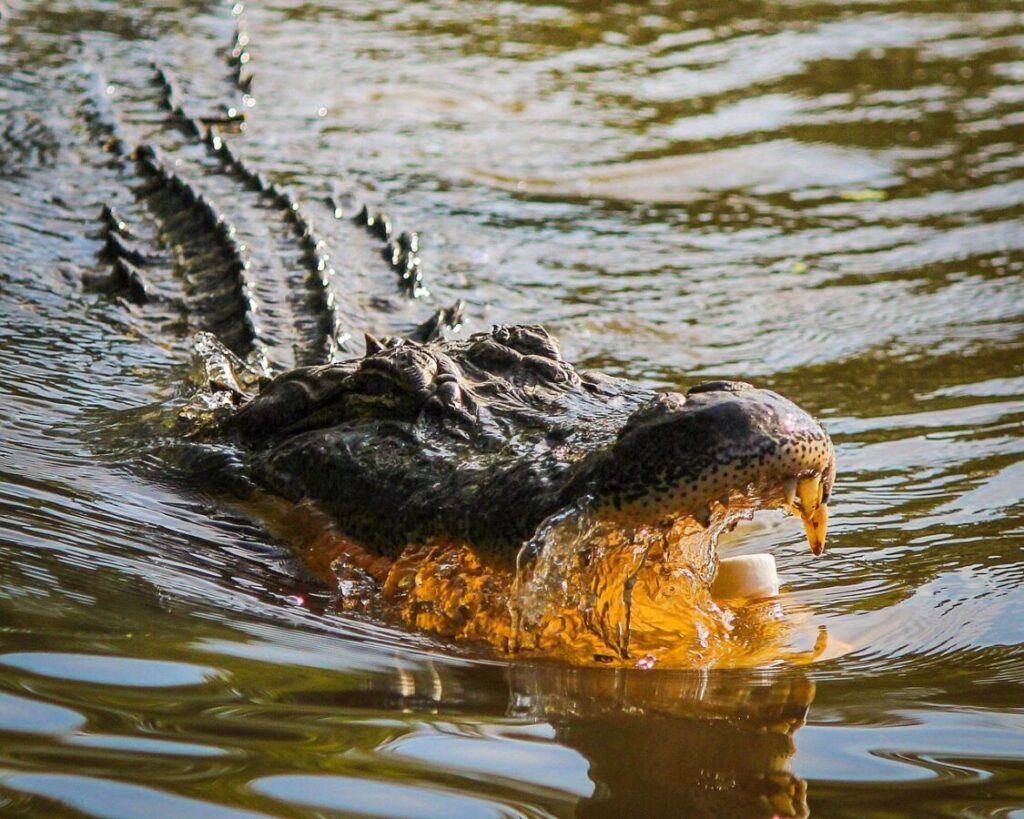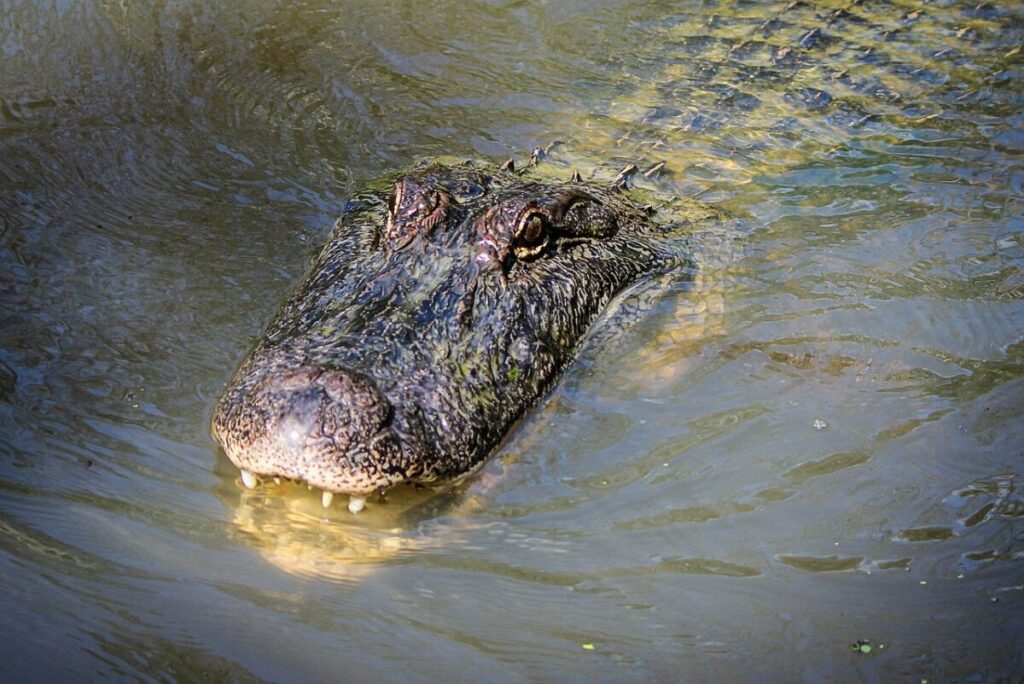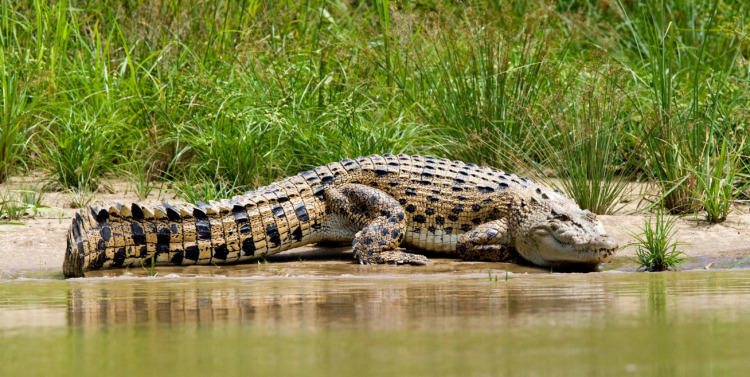Alligators and crocodiles are commonly mistaken for each other, yet they are distinct creatures that belong to different families within the Crocodylia order. These reptiles diverged from a common ancestor millions of years ago during the Late Cretaceous period, leading to varied evolutionary paths. Understanding the differences between these two provides insight into their unique adaptations and roles in ecosystems.
Despite their physical similarities, distinct characteristics such as snout shape, habitat preferences, hunting strategies, and behavior set them apart. This distinction is important for scientific classification and conservation efforts, as each species adapts differently to changing environments.
The American alligator is a member of the Alligatoridae family, while the American crocodile falls under the Crocodylidae family. Alligators can be found primarily in freshwater environments in the southeastern United States and China, showcasing their adaptability to different climates.
In contrast, crocodiles inhabit a broader range of habitats, often living in brackish or saltwater environments across the Americas, Africa, Asia, and Australia.
Their diets vary but generally include fish, birds, and mammals, with hunting methods adapted to their environments. When considering the potential dangers these reptiles pose to humans, it’s crucial to note their typical behaviors and the rarity of aggressive encounters, which are influenced by numerous factors, including habitat proximity and human activity.
Key Takeaways
- Physical and behavioral traits differentiate alligators and crocodiles.
- Each species has adapted to unique habitats and has specific hunting methods.
- Conservation efforts for these reptiles are informed by their distinct ecological roles.
The Difference Between Alligators and Crocodiles
When distinguishing between alligators and crocodiles, one should observe their snouts and teeth. Alligators belong to the family Alligatoridae and typically have a broad and U-shaped snout, which is shorter and rounded.
This U-shaped snout design provides alligators a powerful bite, ideal for crushing their prey. In contrast, crocodiles, in the order Crocodylia, feature a narrow and V-shaped snout that is longer and pointed, allowing these reptiles to snatch fish and other aquatic animals.
| Feature | Alligator | Crocodile |
|---|---|---|
| Snout Shape | U-shaped | V-shaped |
| Visibility of Teeth | Lower teeth not visible when mouth is shut | Large fourth tooth on bottom jaw visible |
The teeth structure offers another clue; alligators‘ lower teeth are generally not visible when their mouths are closed as their upper jaws are wider than the lower. Crocodiles exhibit a different dental display. When their mouths are closed, the large fourth tooth on the bottom jaw of a crocodile is exposed, revealing their narrow and V-shaped jawline.
Although snouts and teeth provide the most immediate visual cues, these reptiles also differ in behavior, habitat preference, and aggressiveness. Alligators are often less visible, spending much time lurking just below the water’s surface, while crocodiles may bask more openly.
These physical and behavioral traits have adapted over millions of years, fitting each species into its niche. Whether it’s a U-shaped snout of an alligator or a V-shaped snout of a crocodile, these characteristics are not just mere aesthetic differences but are functional adaptations that enable their survival.
See Related: These Are The 13 Most Populated Animals in the World Influencing Climate Change
American Alligator vs. American Crocodile

Habitat & Range: The American alligator is often found in freshwater environments, such as ponds, marshes, wetlands, rivers, lakes, and swamps. American crocodiles, however, show a preference for coastal areas and can live in both freshwater and saltwater habitats, including estuaries and mangrove swamps.
Appearance:
- Snout: A key differentiator is the snout shape; alligators have a broader, U-shaped snout, while crocodiles possess a more pointed, V-shaped snout.
- Teeth: When their mouths are closed, the large fourth tooth in the lower jaw of a crocodile is visible, whereas an alligator’s is not because it fits into a socket in the upper jaw.
Size & Color:
- American Alligator: Typically, they can grow to be about 11 feet long and have a dark, almost black coloration.
- American Crocodile: Crocodiles can reach up to 20 feet in length and tend to have a lighter, more grayish-green complexion.
Behavior: Alligators generally have a more reserved demeanor regarding human interaction, tending to avoid humans rather than confront them. Crocodiles are known to be more aggressive, and due to their tolerance for saltwater, they have been known to travel into open ocean, which increases potential human encounters.
Conservation Status:
- American Alligator: Once endangered, their population has recovered and they are now listed as least concern.
- American Crocodile: Listed as vulnerable, American crocodiles’ populations are lower than those of alligators and subject to the pressures of habitat loss and degradation.
Comparing the American alligator and crocodile helps understand the diversity of reptiles adapted to various ecosystems in the Americas. Each species plays a crucial role in their respective environments.
Where Do Alligators and Crocodiles Live?

Alligators and crocodiles are two distinct groups of large reptiles from the order Crocodylia. They thrive in different environments due to their unique physiological needs and adaptations.
Alligators primarily reside in freshwater environments such as ponds, marshes, wetlands, rivers, lakes, and swamps. The American alligator is found in the southeastern United States, with the Florida Everglades being a notable habitat. There is also a less known species, the Chinese alligator, which inhabits the Yangtze River valley in China.
Crocodiles, on the other hand, tend to be more versatile in their habitat preferences, often found in both freshwater and saltwater, including estuaries and mangrove swamps. They are well-suited to brackish water conditions. One well-known species, the Nile crocodile, can be found in various parts of Africa and favors lakes, rivers, and marshlands.
Both species exhibit significant differences in their tolerance to salinity. Crocodiles possess specialized salt glands under their tongue, which allow them to excrete excess salt from their bodies. This adaptation makes them more capable of living in saltwater environments than alligators.
An exceptional area where both alligators and crocodiles co-exist is South Florida. This unique region provides suitable habitats, including marshes, rivers, and mangrove swamps which cater to the preferences of both these reptiles.
| Feature | Alligators | Crocodiles |
|---|---|---|
| Preferred Habitat | Freshwater | Freshwater, Saltwater, Brackish Water |
| Geographic Range | Southeastern US, Eastern China | Africa, Asia, Americas, Australia |
| Salinity Tolerance | Low | High |
By understanding these environments and the distinct characteristics of each, conservation efforts can be better directed to protect these ancient creatures.
What Do Alligators and Crocodiles Eat?

Alligators and crocodiles are formidable apex predators with diets reflecting their top position in their respective ecosystems. Alligators, primarily found in freshwater environments such as rivers, lakes, and marshes, exhibit opportunistic feeding habits. Their diet includes various prey such as fish, birds, and mammals. Smaller alligators often consume invertebrates and fish, while larger individuals can take down larger mammals, including deer.
Young Alligators:
- Fish
- Invertebrates
- Small birds
Adult Alligators:
- Larger fish
- Birds
- Mammals (e.g., deer)
Crocodiles, which inhabit both freshwater and saltwater habitats, are known for a similarly varied diet. They feed on almost anything they can overpower, which includes fish, birds, turtles, and mammals. Their hunting strategies involve stealth, power, and speed, allowing them to ambush unsuspecting potential prey near water edges.
Young Crocodiles:
- Small fish
- Crustaceans
- Insects
Adult Crocodiles:
- Large fish
- Birds
- Mammals (e.g., antelope)
Both alligators and crocodiles have been observed to engage in cannibalism, particularly during periods of food scarcity. These reptiles are adapted to a wide range of prey, which sustains their position as dominant predators in their habitats. Their powerful jaws and muscular tails provide the necessary tools to catch and subdue a variety of prey items, ensuring they remain at the top of the food chain.
See Related: These Are Creepy! 18 Different Types of Eels in the World
Alligator vs. Crocodile: How Do They Hunt?

Stalking their prey with silent precision, alligators and crocodiles have evolved specialized hunting methods adapted to their environments. They both utilize their powerful bite and ambush tactics, but they exhibit differences in behavior and hunting strategies.
Alligators’ Hunting Methods

Alligators thrive in freshwater areas and rely heavily on the element of surprise. They implement stealth to approach their prey undetected before utilizing their powerful bite to capture and overpower it. Typically found in swamps, marshes, and rivers, alligators often float just below the water’s surface, where only their eyes and nostrils are visible, patiently waiting for unsuspecting prey to come close enough for a quick ambush.
- Key behaviors:
- Surprise attack from below the water
- Overpowering prey with strong jaws
Crocodiles’ Preying Habits

Crocodiles, particularly the saltwater crocodile, are known for being more aggressive than alligators. Thanks to their specialized salt glands, they can be found in saltwater and freshwater habitats, which allow them to excrete excess salt. Their hunting strategy involves a swift ambush, propelled by their enormous bite force, considered the strongest of any living animal. Crocodiles may also venture onto land or lurk near water edges to snatch animals that come to drink.
- Notable traits:
- Strongest bite force among all animals
- Utilization of salt glands to inhabit diverse waters
Alligator vs. Crocodile: Who Would Win in a Fight?

Regarding alligators and crocodiles, key differences may influence the outcome of a confrontation.
Size and Strength:
Crocodiles typically grow larger than alligators, with some species of crocodiles reaching over 18 feet in length, while alligators are generally shorter, with maximum lengths of about 14 feet. Larger size could give crocodiles a physical advantage in a fight.
Bite Force:
While both reptiles have impressive bite forces, crocodiles boast one of the strongest bites in the animal kingdom. Their bite can exert immense pressure, greater than that of an alligator, offering a potential advantage in subduing opponents.
Aggression Levels:
Crocodiles are often deemed more aggressive than alligators, particularly saltwater crocodiles. This temperament could tip the scales in favor of crocodiles when it comes to confrontations.
| Trait | Alligator | Crocodile |
|---|---|---|
| Size | Up to 14 feet in length | Up to 18 feet or more |
| Bite Force | Strong, but less than crocodiles | Among the strongest in the animal world |
| Aggression | Comparatively less aggressive | Often more aggressive |
In a fight, one would have to consider these factors alongside environmental conditions and the specific species involved. While the size and bite force of crocodiles could be more significant, an alligator’s agility and speed should not be underestimated. It’s a close call and specifics matter; indeed, the nuances of an alligator and a crocodile’s behavior and physicality are critical to the fight’s potential outcome.
Alligator vs. Crocodile— Which Is More Dangerous to Humans?

When assessing danger to humans, crocodiles generally pose a greater threat than alligators. Crocodiles, like the Nile crocodile and the saltwater crocodile, tend to be more aggressive, which directly correlates to their interactions with humans.
Alligators, specifically the American alligator, show comparatively less aggression. Their encounters with humans often result from habitat overlap and are not typically characterized by the same level of aggression seen in their crocodilian relatives.
These reptiles’ teeth and snout shape provide insights into their behavior and diet. Crocodiles have a V-shaped snout and their teeth are visible when their mouths are closed, suggesting a more diverse range of prey, including large mammals. On the other hand, alligators have a U-shaped snout, which is more suited to a diet of fish and invertebrates, reflecting a less aggressive nature.
| Feature | Alligator | Crocodile |
|---|---|---|
| Snout Shape | U-shaped | V-shaped |
| Teeth Visibility | Not visible when mouth closed | Visible when mouth closed |
| Typical Behavior | Less aggressive | More aggressive |
The habitat also plays a role; alligators are often found in freshwater environments, whereas crocodiles can also inhabit saltwater areas, potentially leading to more human interactions for the latter. While both should be respected and avoided in the wild, statistics and behavioral studies indicate that crocodiles are more dangerous to humans than alligators.
The Lifespan of an Alligator vs. Crocodile

When examining the longevity of these reptiles, it becomes apparent that both alligators and crocodiles are capable of impressive lifespans under optimal conditions.
Alligators: They typically live for 30 to 50 years in the wild. In captivity, due to regulated diets and absence of predators, alligators have been known to live longer, some exceeding 60 years.
Crocodiles: These reptiles generally have a longer lifespan than alligators. In the wild, many species live on average 40 to 60 years, with some individuals reaching 70 years. Captivity again can extend their lifespan, sometimes up to around 80 years.
Factors Influencing Longevity:
- Habitat: Secure habitats contribute to longer lifespans. Loss of habitat due to human activity can negatively affect these animals.
- Conservation efforts: Play a significant role in improving the lifespan by safeguarding their environments and combatting illegal hunting.
- Endangered Status: Some species are at risk. For example, the critically endangered Chinese alligator has a shorter expected lifespan due to pressures from habitat loss and human encroachment.
| Species | Average Lifespan (Wild) | Lifespan (Captivity) |
|---|---|---|
| Alligators | 30-50 years | Up to 60+ years |
| Crocodiles | 40-70 years | Up to 80 years |
Protection and well-maintained environments are key for the survival and longevity of these ancient reptiles. With ongoing conservation efforts, the hope is that alligators and crocodiles will continue to thrive for many generations.
Alligator vs. Crocodile: Fun Facts

Alligators and crocodiles are often confused for one another, but there are distinct differences that set them apart. Notably, crocodiles are typically found in saltwater habitats due to their functioning lingual salt glands which allow them to excrete excess salt from their bodies. On the contrary, alligators possess these glands as well but they are not functional, leading to their preference for freshwater environments.
Their physical appearance offers clues to their identity:
- Color: Crocodiles often have a lighter, more olive or tan coloration compared to alligators, which are usually darker grey or black.
- Feet: An important distinction can be noted in their feet; alligators have webbed feet which aid them in swimming in freshwater, whereas crocodiles have more pronounced, jagged fringe along their feet.
- Snout Shape:
- Alligators possess a broad, U-shaped snout.
- Crocodiles have a narrower, V-shaped snout.
Interestingly, the jaw structure between the two reptiles contributes to a notable feature: when their mouths are closed, an alligator’s upper jaw is wider than its lower jaw, which hides its lower teeth and gives it a smooth overbite look. In contrast, a crocodile’s fourth tooth on the lower jaw is visible even when its mouth is closed, due to the narrow upper jaw.
The differences between these two powerful reptiles are as intriguing as they are functional, reflecting their adaptation to different environments and ways of life.
Predators of Alligators and Crocodiles
Alligators and crocodiles sit near the top of the food chain in their respective ecosystems; however, they are not without threats. As apex predators, they primarily face danger from humans and other large animals within their habitats.
Alligators

In their early stages, alligators can fall prey to birds, raccoons, bobcats, and other carnivores that can seize the opportunity for a meal. Adult alligators, on the other hand, rarely face predation threats due to their size and strength. However, cases exist where they can be attacked by larger specimens of their kind or by other large predators.
Crocodiles

Crocodile hatchlings are vulnerable to a similar set of predators as their alligator counterparts, including large fish and birds. Adult crocodiles, which can grow significantly larger than most alligators, maintain few natural predators, with the occasional challenge coming from big cats, like lions and tigers in certain ranges, or from other crocodiles.
- Habitat Loss: Both species are increasingly threatened by habitat destruction. Gusts of urban expansion, pollution, and changes in land use are contributing to the loss of critical wetland environments.
- International Union for Conservation of Nature (IUCN): Many crocodile species are listed on the IUCN Red List of Threatened Species, signifying varying degrees of vulnerability and endangerment, largely attributable to human activity.
Efforts for conservation are paramount to ensure the survival of these ancient reptiles, emphasizing the necessity of protecting their environments and enforcing anti-poaching laws.
See Related: Different Types of Beetles Around the World
Could a Lion Beat a Crocodile in a Fight in the Wild?

In considering the potential outcome of a confrontation between a lion and a crocodile, several factors must be assessed.
Physical Attributes:
- Lion: Renowned for their strength and agility.
- Crocodile: Possesses powerful jaws and a notorious death roll.
Habitat and Range:
- Lions typically avoid water, limiting encounters with aquatic reptiles.
- Crocodiles occupy freshwater environments like rivers where lions come to drink.
Aggression and Behaviour:
- Lions are ambitious predators, but they tend to be cautious around waterbodies known to harbor crocodiles.
- Nile and saltwater crocodiles are particularly aggressive and would defend their territory fiercely.
Encounter Dynamics:
- The crocodile’s ambush strategy could lead to a swift victory if a lion is unaware at the water’s edge.
- On land, the lion’s maneuverability could provide an advantage over the less agile crocodile.
A battle between a lion and a crocodile could favor either, depending on the circumstances. It is crucial to note that such interactions are rare in the wild and often avoided by both species.
Related Resources:
- Important Farming Skills You Need to Know
- What Are Species? Definition & Guide to Biodiversity
- Different Types of Biomass To Know


